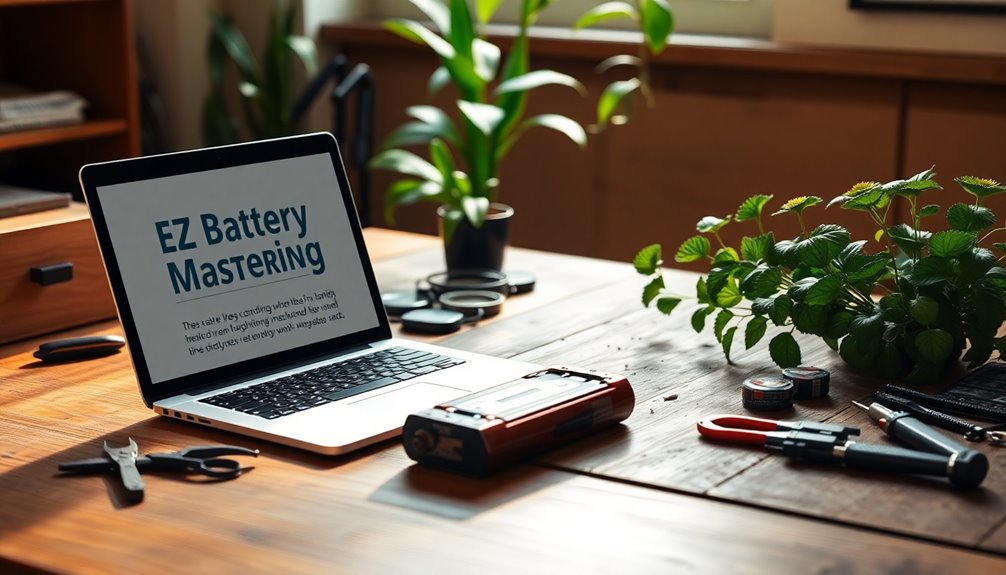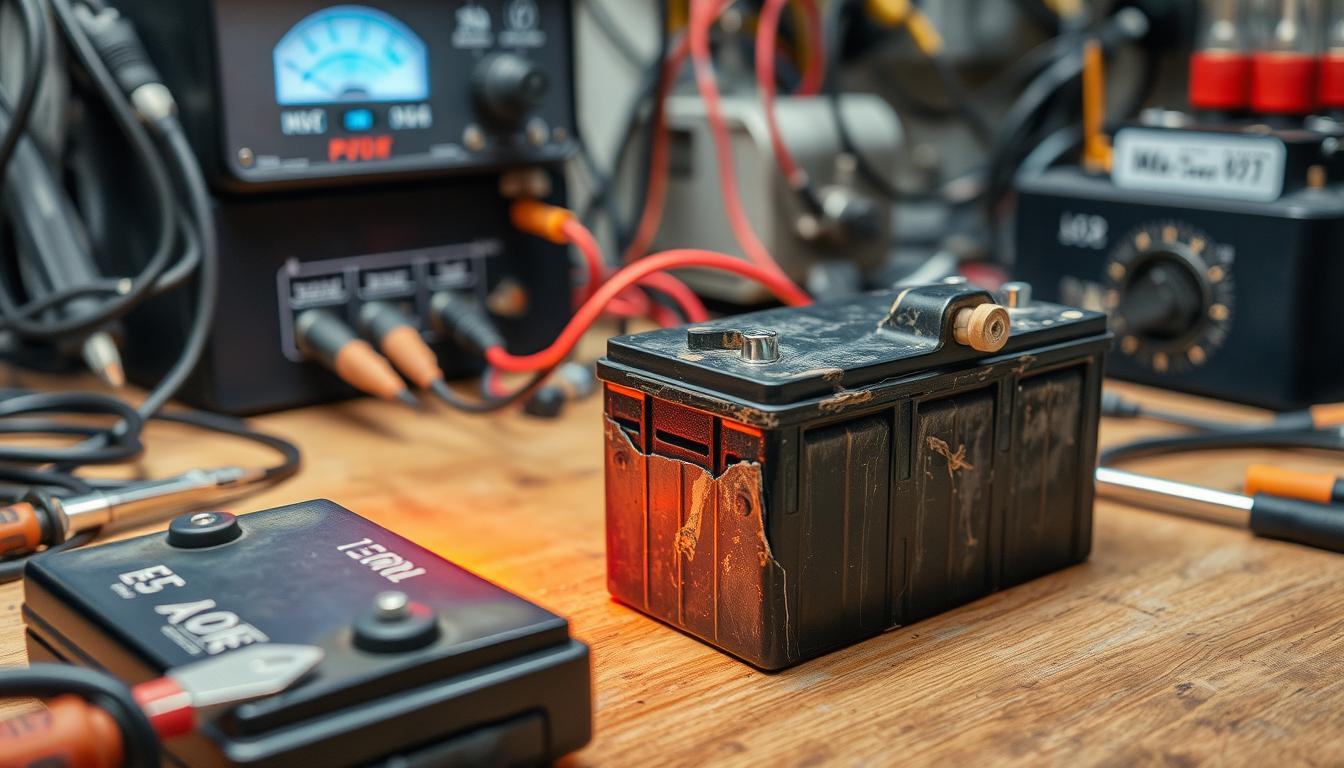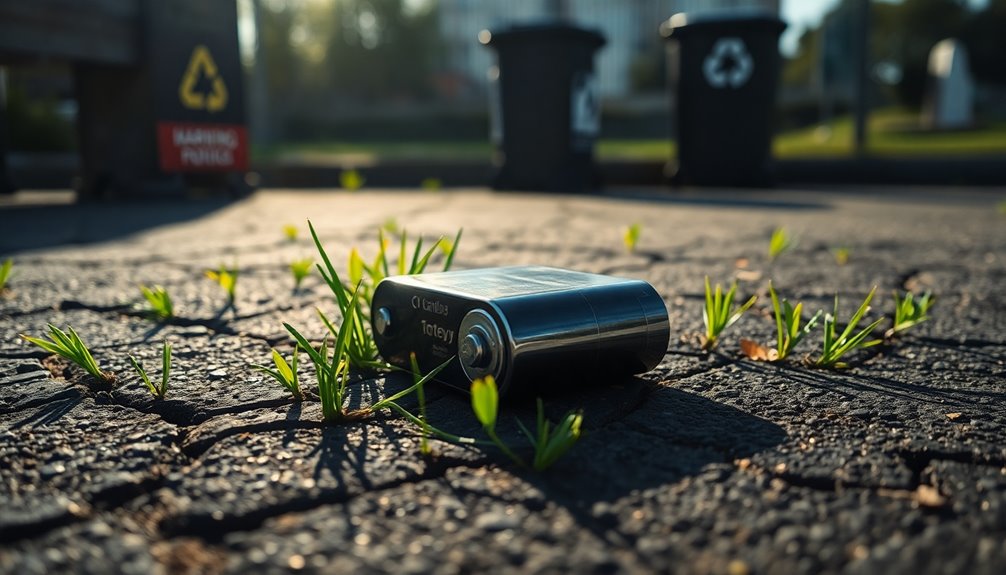Starting a battery reconditioning business can be rewarding, but you'll face challenges along the way. First, conduct thorough market research to identify your target customers and their needs. Develop essential technical skills related to battery types, diagnostics, and safety practices. Invest in the right equipment to ensure efficiency. Choose a strategic location that meets demand while adhering to compliance regulations. Don't forget financial management; create forecasts and monitor costs to maintain profitability. Finally, keep an eye on competition and evolving market trends. You'll discover more strategies to tackle these challenges effectively as you navigate this exciting journey.
Key Takeaways
- Invest in advanced diagnostic technologies to accurately assess battery conditions and improve reconditioning efficiency.
- Maintain a strong understanding of battery types and chemistry to tailor services to different customer needs.
- Implement cost-effective solutions and competitive pricing strategies to enhance customer retention and attract new clients.
- Ensure compliance with federal and state regulations to avoid penalties and build a trustworthy business reputation.
- Regularly monitor financial health and adapt strategies based on performance for sustainable growth.
Market Research Strategies

Conducting thorough market research is crucial for anyone looking to succeed in the battery reconditioning business. Start by identifying your target customers. Understand the demographics, needs, and purchasing behaviors of potential clients, whether they're individuals, small businesses, or large corporations.
Focus on segments that heavily depend on batteries, like electronic device users and the automotive industry. Customer surveys can help you gather valuable insights.
Next, understand your competition. Conduct a competitor analysis to identify market leaders and their strategies. Evaluate their strengths, weaknesses, pricing models, and service offerings.
This will help you pinpoint the gaps in the market that you can address. Additionally, the global tea market is valued at approximately $200 billion, showcasing the vast potential of industries reliant on consumable goods.
Don't forget to evaluate demand and supply. Assess the current demand for reconditioned batteries and analyze trends in battery usage. Understanding the supply chain for raw materials and the availability of skilled labor is essential for your operational planning. Additionally, consider that the global battery reconditioning market is projected to grow at a CAGR of 6.2% from 2020 to 2025, indicating a strong potential for profitability.
Finally, analyze the market potential. Calculate the market size and potential revenue, and consider the growth rate of the battery reconditioning sector.
Essential Technical Skills

Mastering essential technical skills is vital for anyone in the battery reconditioning business. You'll need a solid understanding of different battery types and their chemistry. For instance, with lead-acid batteries, you should know how to desulfate using high-frequency pulses and perform equalization charging to balance cell voltage.
Regularly check water levels in flooded batteries and use a multimeter to measure cell voltages, identifying weak or dead cells. Understanding battery chemistry is crucial, as it helps you recognize specific issues like sulfation in lead-acid batteries and dendrite formation in lithium-ion batteries that may require reconditioning.
Diagnostic and testing skills are equally important. You'll frequently measure battery and cell voltages, identify imbalances in lithium-ion cells, and conduct load tests to evaluate overall performance. A hydrometer will help you assess electrolyte density, ensuring you can pinpoint any weak or bad cells.
Additionally, mastering charging and discharging techniques is crucial. Controlled overcharging for lead-acid batteries and using balancing chargers for lithium-ion batteries can extend battery life. Always manage temperature during charging to prevent damage.
Finally, prioritize safety. Wear protective gear, work in well-ventilated areas, and ensure proper maintenance practices, such as cleaning terminals and checking electrolyte levels.
These skills not only enhance your reconditioning efforts but also ensure your safety and success in the business.
Necessary Equipment Overview

When starting a battery reconditioning business, having the right equipment is crucial for efficiency and effectiveness. You'll need a variety of tools tailored to different battery types.
For example, multimeters help you measure voltage, current, and resistance, allowing you to identify battery issues quickly. Smart chargers use advanced cycles to safely recharge and restore battery power, while desulfators tackle sulfate buildup, a common culprit behind power loss.
Your toolkit should also include battery load testers to check current supply capability and battery post cleaners to remove any corrosion. Depending on the battery type, you might require specific equipment: lead-acid batteries need hydrometers and adjustable chargers, while lithium-ion batteries require cell balancers and specialized chargers.
Don't overlook safety; safety glasses and rubber gloves are essential to protect yourself from chemicals and electrical hazards. A plastic funnel can help you safely add chemicals, and paper towels will be handy for cleaning spills. Additionally, investing in high-quality equipment can significantly improve the overall efficiency of your reconditioning process.
Finally, make sure you budget for both initial equipment costs and long-term maintenance expenses to ensure your business runs smoothly and profitably.
Optimal Location Selection

Choosing the right location for your battery reconditioning business can significantly impact its success. You'll want to identify areas with a strong demand for your services while carefully assessing the competition. Conduct market research to understand local needs and competitors, ensuring you're not entering an oversaturated market.
Affordability is another key factor. Weigh the costs of operating in densely populated areas against potential profitability. It's crucial to ensure the location can generate enough sales to justify your expenses. Compare the costs and benefits of different location options to find the best balance. Cost efficiency involves sourcing quality parts at competitive prices and optimizing processes in your chosen area.
Additionally, make sure your chosen site meets environmental and safety standards. Evaluate traffic flow, entry and exit points, and lighting conditions for safety. If you plan to offer 24/7 service, consider mobile data signal strength and accessibility.
Decide whether a physical brick-and-mortar setup or an online operation suits your needs best. A home-based operation might be ideal for the initial stages, but as your business grows, a commercial location could enhance visibility and convenience.
Always keep accessibility in mind as you finalize your location choice.
Financial Management Tips

Effective financial management is essential for the success of your battery reconditioning business. Start by creating a detailed financial forecast that includes sales projections, expense forecasting, and cash flow projections. Aim for sales growth that meets or exceeds inflation rates, and don't forget to account for seasonal variations in revenue and expenses.
Your profit and loss statement should analyze expected profitability over the first three to five years, giving you insight into net margins. When considering funding, evaluate both equity and debt options, ensuring you separate interest expenses from principal repayments in your financial model. Additionally, incorporating key components of financial forecasting will enhance the accuracy of your projections and decision-making process.
Keep a close eye on operational costs, including personnel, utilities, and marketing. Allocate funds wisely for equipment, rent, and insurance to avoid any surprises.
Regularly update your cash flow forecast to maintain liquidity and anticipate financing needs.
Lastly, diversify your revenue streams through battery sales, recycling, and maintenance services. By staying proactive in monitoring your financial health and adapting your strategies, you'll set a strong foundation for your battery reconditioning business to thrive.
Navigating Competition
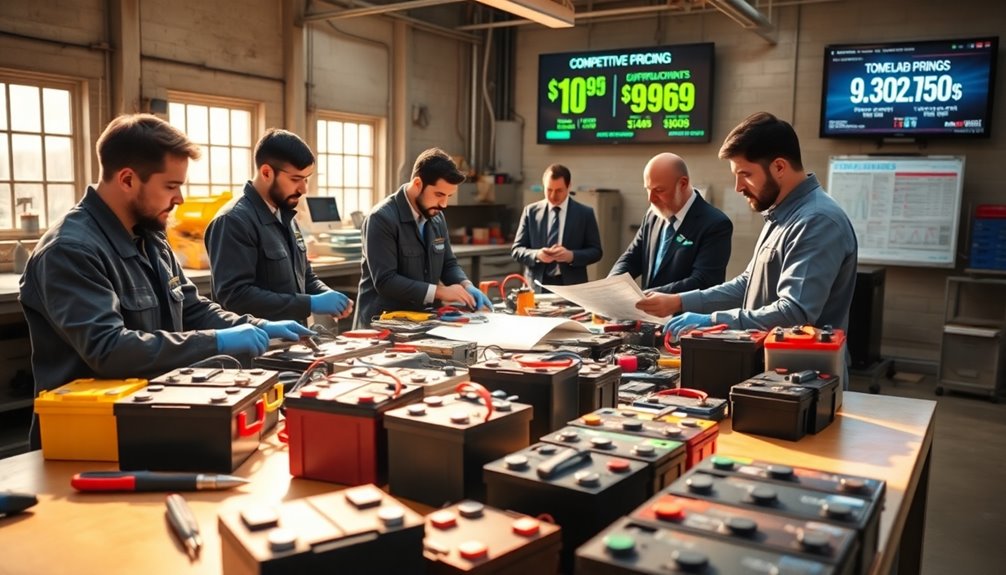
Navigating the competitive landscape in the battery reconditioning business can be challenging, especially with numerous players vying for market share. Key competitors like Allied Battery Co., Battery Solutions LLC, and Stryten Manufacturing LLC dominate the North American market, which is seeing increased competition due to the surge in electric vehicles and renewable energy systems. To stand out, you'll need to identify and focus on specific market niches, such as lead-acid batteries or specialized services for the automotive and electronics sectors. Emphasizing sustainability can also give you an edge. Many customers today prioritize eco-friendly practices, so highlighting your commitment to reducing electronic waste can attract more clients.
Offering cost-effective solutions is crucial, as many customers are looking for affordable alternatives. Given that the Battery Rebuild Service Market is projected to grow to US$ 6.18 billion by 2030, this presents a significant opportunity for businesses to capitalize on emerging trends. To develop competitive strategies, invest in advanced diagnostic technologies and ensure your team is well-trained in high-quality reconditioning practices. Forming partnerships can also enhance your market presence. Lastly, consider implementing competitive pricing and customer incentives to retain clients. By navigating the competitive landscape strategically, you can position your business for success in this growing industry.
Regulatory Compliance Essentials
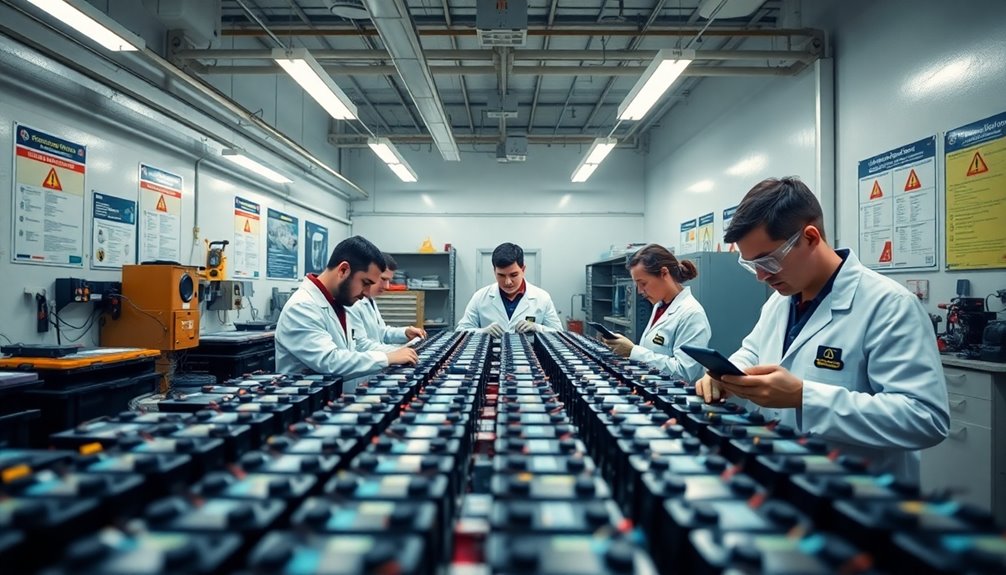
While entering the battery reconditioning business can be rewarding, understanding and adhering to regulatory compliance is essential for your success.
You'll need to navigate a complex web of federal and state regulations that govern how you handle batteries, particularly hazardous materials. The U.S. Department of Transportation's Hazardous Material Regulation outlines strict packaging and labeling requirements. Under the Resource Conservation and Recovery Act, you must manage waste responsibly and avoid illegal disposal practices.
You'll also need to stay compliant with the Universal Waste Rule, which mandates that certain batteries, like nickel cadmium and small sealed lead acid, be recycled, not thrown away. Moreover, it's important to recognize that regulatory requirements are applicable throughout the entire battery life cycle.
Don't overlook state-specific regulations, as some states require collection programs for these batteries.
Keeping thorough records is crucial for demonstrating compliance and meeting retention obligations. Implement training and safety measures to ensure your team understands the handling of hazardous materials.
Lastly, remember to register with your local pollution control board and file necessary returns. By staying informed and proactive about regulatory compliance, you'll not only avoid costly penalties but also build a reputable business in the battery reconditioning industry.
Frequently Asked Questions
What Are Common Mistakes in Starting a Battery Reconditioning Business?
When starting a battery reconditioning business, you might overlook the importance of identifying your target market. Not understanding customer needs or the competitive landscape can lead you astray.
Additionally, failing to analyze demand and supply accurately can hinder your growth. Lacking technical knowledge about battery types and safety protocols is another common pitfall.
Lastly, poor business planning and high overhead expenses could significantly impact your profitability. Stay vigilant to avoid these mistakes!
How Do I Find My First Customers for Battery Reconditioning?
To find your first customers for battery reconditioning, start by tapping into your local community.
Attend events like car shows or electronics fairs to showcase your services. Network with small businesses and repair shops that could benefit from cost-effective battery solutions.
Utilize social media to promote your offerings and highlight eco-friendly practices.
You can also create a website to attract online customers, offering clear information about your services and their benefits.
What Are the Best Marketing Strategies for This Business?
To effectively market your battery reconditioning business, leverage social media to connect with your target audience and create a professional website that showcases your services.
Utilize Google and Facebook ads to boost visibility and drive traffic. Engage influencers to promote your brand and consider partnerships with businesses that rely on batteries.
Don't forget traditional marketing techniques like local newspapers and community events to widen your reach and build credibility.
How Can I Improve My Battery Reconditioning Skills Over Time?
To improve your battery reconditioning skills over time, focus on hands-on practice with various battery types.
Enroll in specialized training programs and certification courses to deepen your knowledge.
Attend workshops and industry conferences to learn from experts and network with peers.
Utilize specialized tools like multimeters and smart chargers, and always seek feedback from experienced professionals.
Stay updated on industry developments through publications and online forums, ensuring you're aware of the latest techniques and technologies.
Are There Any Online Courses for Battery Reconditioning Training?
Yes, there are several online courses available for battery reconditioning training.
These courses cover essential topics like battery types, diagnostic techniques, and hands-on training. You'll learn about various electro-chemistries, stress testing methods, and practical skills necessary for battery maintenance.
Many programs also offer certification, which can enhance your qualifications in the field. By enrolling, you'll gain valuable knowledge and practical experience that'll help you excel in battery reconditioning.
Conclusion
Starting a battery reconditioning business can be rewarding, but you've got to be prepared for the challenges. By conducting thorough market research, honing your technical skills, and selecting the right equipment and location, you'll set yourself up for success. Keep your financials in check, stay ahead of the competition, and ensure you comply with regulations. With the right approach, you'll not only overcome obstacles but thrive in this growing industry. Get ready to make your mark!


